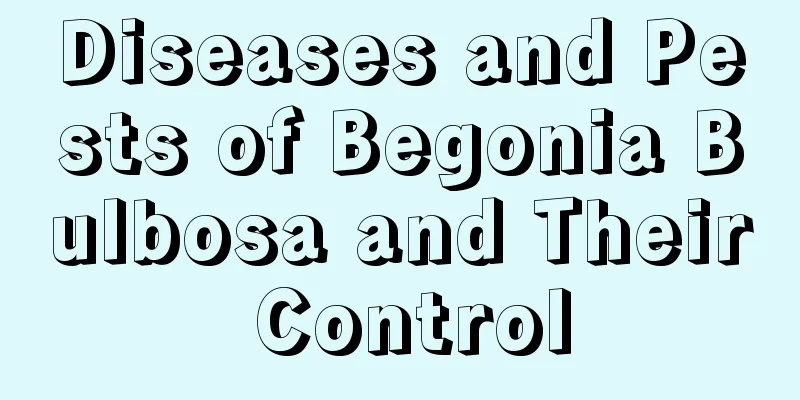Diseases and Pests of Begonia Bulbosa and Their Control

Common diseases of bulbous begoniapowdery mildewThe disease mainly harms the above-ground parts of bulbous crabapple plants. The specific symptoms are that in the early stage of the disease, sporadic white mildew spots will appear on the affected parts, and gradually expand and connect into one piece, the leaves will turn yellow and fall off, and even the flowers will not bloom. Excessive nitrogen fertilizer, poor ventilation, and overly dense planting can easily induce powdery mildew. The prevention and treatment methods are as follows: ①Control the amount of nitrogen fertilizer used; ② Before the disease occurs, spray 400-600 times diluted 60% mancozeb wettable powder once every two weeks. In the early stage of the disease, spray 1000 times diluted 70% thiophanate-methyl or 1000-2000 times diluted 15% trifloxypropyl group-9 for prevention and control. Stem rotThe disease is more serious in spring and on cloudy days. The specific symptoms are that in the early stage of the disease, small dark spots in the shape of water stains will appear on the stems and leaves of the plant, and they will gradually expand. White filaments will appear on the diseased parts, and brown granules will appear after drying. Prevention and control methods: In the early stage of the disease, you can spray carbendazim or 65% dichlorodiphenyltrichloroethane 600-800 times solution. Botrytis cinereaThe disease is very harmful and can damage the entire plant, especially the stem. In the early stage of the disease, water-soaked spots appear on the stems, gradually expanding into a soft rot state, causing the plant to fall over. This disease is more likely to occur when the humidity is too high or the plants are planted too densely. The prevention and treatment methods are as follows: ① Pay attention to ventilation and light transmission, and control humidity; ② In the early stage of the disease, spraying 70% thiophanate methyl solution 1500 times or 50% mancozeb solution 800-1000 times once every 10 days can effectively prevent and control the disease. Leaf spotThe symptoms are as follows: in the early stage of the disease, the lesions are blister-like, and the color slowly changes from dark green to transparent yellow, and gradually expands into dark brown dead spots with white mucus. Later, they perforate and rupture, causing the death of the plant. The prevention and treatment methods are as follows: ①Disinfect the flower soil frequently. ② The planting density should be reasonable, pay attention to ventilation and light, and avoid splashing water on the leaves when watering. Remove diseased leaves promptly. ③ When the disease is serious, spray 4000 times diluted 72% agricultural streptomycin in time. Common Pests of Begonia bulbiferaCommon insect pests include scale insects, aphids, leaf rollers, thrips, etc. For scale insects, you can spray with 1000 times diluted 40% oxydemeton-methyl emulsifiable concentrate; for thrips, you can spray with 4000 times diluted potassium permanganate; for leaf rollers, you can spray with 0.1 pyrethrin emulsifiable concentrate and 2000 times diluted dermatophyllum, etc. |
<<: Common diseases and pests of holly and their control
>>: Kale pests and diseases and their control
Recommend
What is the use of fishing bell willow
The ornamental function of the willow of fishing ...
How to grow jasmine well
1. Suitable soil If you want to grow jasmine well...
Should Cymbidium orchids be potted in large or small pots?
Should Cymbidium orchids be potted in large or sm...
The harm of trumpet creeper
1. Rich aroma Although the trumpet creeper is not...
How to grow calyx spurredii at home
Growth conditions of calyx spur The calyx spurred...
Can hydrangeas be planted in the ground?
Can hydrangea be planted in the ground? Hydrangea...
Why are coriander seedlings uneven? (Why are coriander seedlings so thin after they emerge?)
Coriander, also known as cilantro, is divided int...
Can the osmanthus tree bloom in winter?
1. Flowering period of the fragrant osmanthus: Fr...
When is the best time to transplant elm trees (elm seedling transplanting time and method)
Elm is a familiar tree species, and bonsai can be...
How to grow snapdragon on the balcony and what to pay attention to
1. Adequate sunlight The growth and maintenance o...
Peanuts planted in water look better than green ivy, and one plant can produce 50 fruits!
Throw a peanut into water and it will turn into a...
Worship! Land and take root, strong reproductive capacity
Reproduction of ground roots These are the small ...
How to plant iron tree seeds
Planting time of iron tree seeds The seeds of the...
What flowers are suitable for growing in Altay, and what are the city flowers and trees?
1. Climate characteristics of Altay Altay has a t...
Cultivation methods and precautions of harp leaf coral (how to grow harp leaf coral flowers)
The lyreleaf coral is now usually grown into a sm...









